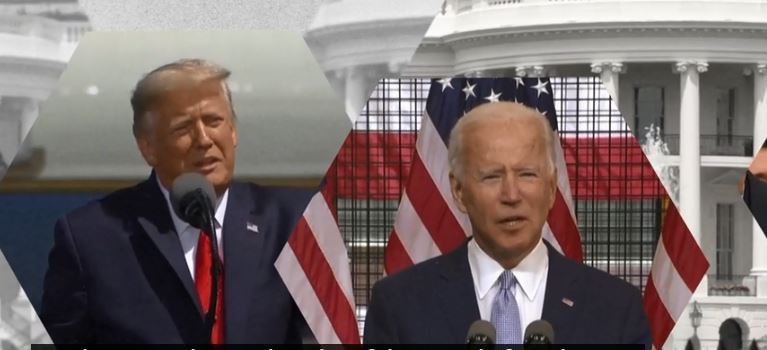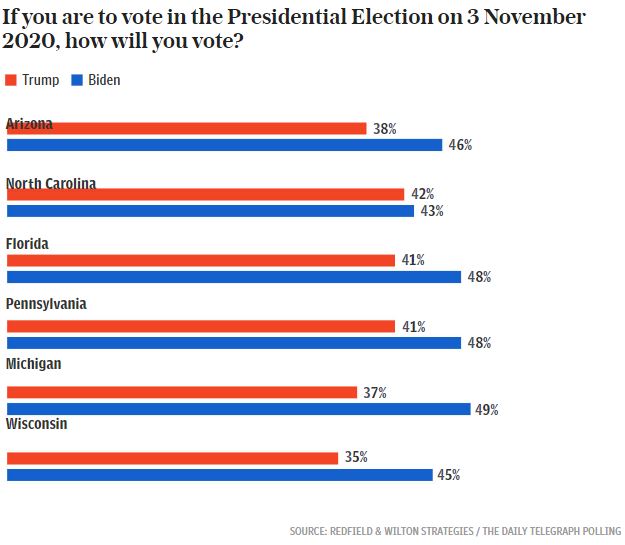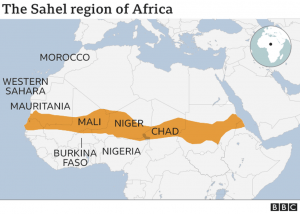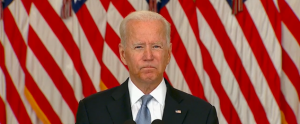
28 October 2020. The Telegraph, UK: ‘What Are The Key Swing States In The 2020 Election, And Who Is Leading The Battleground Polls?’ By Leeanna Faulkner.
The key for either party to win the presidential election is to target specific swing states, also known as battleground or purple states.
These battleground states are areas which have unclear party loyalties, and have historically swung between voting for Republican and Democrat candidates in past elections. They hold the key to winning the US 2020 election.
Due to the winner-takes-all voting system, in all but two states, candidates often choose to campaign in the most competitive states. This is why only select areas receive the majority of adverts during election campaigns.
Here’s everything you need to know about the history of swing states and why their influence can be so powerful in US elections.
What are the key swing states?
There are eight swing states where the 2020 election could be won or lost:
- Arizona
- Florida
- Georgia
- Michigan
- Minnesota
- North Carolina
- Pennsylvania
- Wisconsin

What determines a swing state?
Swing states can shift between each election cycle, and they can be determined by looking at past results, opinion polls, political trends and any strengths or weaknesses of the candidates involved, and their policies. Other areas that can influence gradual shifts of swing states are changes in population and demographics.
Why are they so important?
This year North Carolina, Florida, Michigan, Wisconsin, and Arizona could all be decisive in the election’s outcome. They are all states which Mr Trump won narrowly against Hillary Clinton in 2016, helping him secure his electoral college victory. Retaining them is crucial to his re-election hopes.
The history of swing states
The history of American elections have proved the importance of swing states. In 1948, Harry S. Truman defeated Thomas Dewey with a win of less than one per cent of the popular vote in then-swing states California, Ohio, Indiana, Illinois and New York. The presidential race was so close that newspaper headlines mistakenly reported Mr Dewey as the winner.
The 1960 presidential election between Nixon and John F. Kennedy saw 10 states won by less than two per cent of the vote. In 2000, the election results came down to Florida’s win, which George W. Bush claimed by a margin of just 537 votes.
Who is leading in the battleground state polls?
If the polls are to be trusted, Mr Biden holds a competitive edge over Mr Trump in all of them.
Pollsters attributed Mr Biden’s lead to support among white university-educated voters, while Mr Trump’s support among white working-class voters is waning.
Currently, the 10-poll average indicates that just over half of Americans intend to back Mr Biden while Mr Trump’s support trails this by around five or six points.
How does the Electoral College work?
All 50 US states and Washington DC have a set number of “electors” in the electoral college – roughly proportionate to the size of each state.
Each state gets at least three electoral votes because the amount is equal to its total number of Senators and Representatives in the US Congress. Washington DC also gets three electoral college votes, meaning a total of 538 electors form the Electoral College.
California, the largest state, has 55 electoral votes, Texas, the next largest, gets 38. New York and Florida have 29 each.
All but two states – Maine and Nebraska – use a winner-takes-all system, so if you win the most votes in a state, you take its entire haul of electoral college votes.
To become president either candidate needs to win a majority of the 538 electors; ie 270 electors.
While the Constitution does not dictate that electors follow the popular vote, many US states have laws requiring them to do so. These laws have been challenged by electors voting for someone else on occasion, but in July, the US Supreme Court ruled that electors must follow the popular vote in states that have passed such a law.
The electoral college system does usually reflect the popular vote – presidents have won the electoral vote while losing the popular vote just five times in US history. The most recent instance was in 2016, when Donald Trump won the electoral college but Hillary Clinton, his Democratic opponent, won the popular vote.




